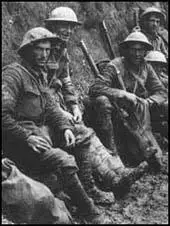Italian Army

The Italian Government introduced military conscription in 1907. However, only about 25 per cent of those eligible for conscription received training. By 1912 there were 300,000 in the Italian Army but critics pointed out that there was a shortage of experienced NCOs and trained officers.
In July 1914 General Luigi Cadorna became chief of staff of the Italian Army. Although the Italian government declared its intentions to be neutral on the outbreak of the First World War in August 1914, Cadorna expected war and began building up his army. He decided to concentrate his forces on the borders with Austria-Hungary.
At a secret meeting held in England on 26th April 1915, representatives of the Italian government agreed to enter the war in return for financial help and the granting of land currently under the control of Austria-Hungary. The Treaty of London resulted in Britain granting an immediate loan of £50 million and a promise to support Italian territorial demands after the war.
By the spring of 1915 General Luigi Cadorna had 25 infantry and 4 cavalry divisions. Grouped into four armies, Cadorna only had 120 heavy or medium artillery pieces and some 700 machine guns. Despite the shortage of artillery Cadorna launched mass attacks on Austria-Hungary in May 1915. The defending army quickly built trenches and the Italians suffered heavy casualties. In the first two weeks of the Isonzo Offensive, the Italian Army lost 60,000 men. By the time the attacks were called off that winter, Italian casualties had reached 300,000. Cadorna had also lost 3,000 field guns.
Cadorna made seven attempts to break through enemy lines but his only substantial victory was at Gorizia in August 1916. The Austro-German Caporetto Offensive in October 1917 was disastrous for the Italian Army. Over 300,000 men and most of its trench artillery was lost and the following month General Luigi Cadorna was replaced by General Armando Diaz.
Diaz managed to stabilize the front-line but was unwilling to undertake an offensive of his own. Vittorio Orlando, the Italian prime minister, was aware that he would need military victories to strengthen his negotiating position to obtain territorial demands after the war. He therefore pressurized General Armando Diaz to launch an offensive in a war that would soon be over.
On the 23rd October 1918, Armando Diaz launched an offensive at Vittorio Veneto. Diaz was able to put 57 Italian divisions in the field. These were supported by soldiers from the French Army and the British Army.
After initial difficulties crossing the Piave River, the Italian Army took the town of Vittorio Veneto. The Austro-Hungarian Army collapsed and by the Armistice the Allied forces had reached Trento in the west and Tagliamento in the east. When the ceasefire was called on 2nd November, the Italians had taken 300,000 prisoners.
The Italy's total wartime casualties was 420,000 killed and almost 955,000 wounded out of the 5.2 million men who served during the First World War.
